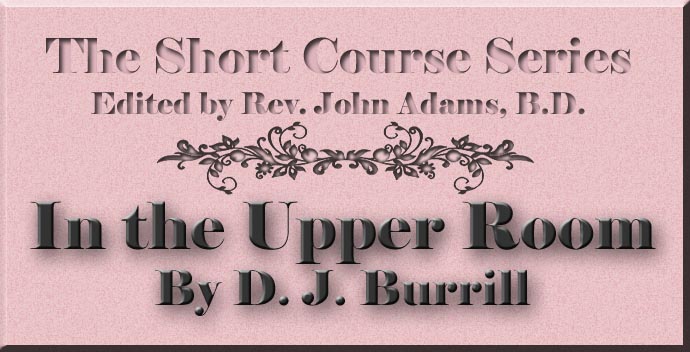
THE SHORT COURSE SERIES
Edited by Rev. John Adams, B.D.
In the Upper Room
A PRACTICAL EXPOSITION OF JOHN 13-17.
By Rev. D. J. Burrill, D.D., LL.D.
Appendix
Some Additional ReadingThe subject dealt with in the foregoing pages may be fitly described as "The Most Holy Place" of the Gospel. Viewed, as it must be, in relation to the institution of the Supper, it naturally appeals to the student or preacher who looks forward, season by season, to a due celebration of the feast The literature on the subject is no doubt enormous, yet no one need experience the slightest difficulty in singling out the "helps" which he has found most serviceable in his own ministry. One of these is unquestionably Godet’s Commentary on St. John: for, as Principal Edwards so justly remarks: "One of Godet’s excellences is clearness.... He is less penetrating than Calvin, less felicitous than Bengel, not so learned as Meyer, nor so bold as Hofmann; but for spiritual insight give us Godet." To preachers and teachers alike we still consider him one of the most helpful and suggestive of commentators. And the same claim may be advanced for the sanity and lucidity of Bruce’s Training of the Twelve — chapters xxi.-xxvi. These chapters are remarkably luminous and satisfying, and may well be included among the expository material connected with the Upper Room. On the devotional aspects of the subject nothing could be more helpful than Love Revealed, by George Bowen of Bombay, or The Spirit of Christ, by Dr. Andrew Murray. These will help to produce the right kind of atmosphere for the study of so sacred a theme, and will always repay the most prayerful examination at each communion season. Two other studies, of more than passing interest to the practical expositor, are worthy of being added to the present list. We refer to Stanley’s account of the "Samaritan Passover" in The Jewish Church (vol. i. pp. 443-451), and David Baron’s treatment of "The Conclusion of the Hallel" in The Ancient Scriptures and the Modern Jew (pp. 99-122). These help to infuse something of the historic sense, apart from which all devotional or even exegetical study is in large measure inadequate. Expository preaching is dependent on all the three. Historical imagination, spiritual intuition, and exegetical fidelity and skill are all needed for a due appreciation of the text. In addition to the above, the following are strongly recommended: (1) The Life and Writings of St. John, by Dr. James M. Macdonald; particularly chapters xii. and xiii.; (2) Commentary on the Gospel of St. John, chapters xiii.-xvii., Dr. H. R. Reynolds and Dr. T. Croskey; (3) Eight Sermons on the Upper Room by Dr. Alexander Madaren, in a volume entitled Last Sheaves; (4) Bishop Ryle’s Expository Thoughts on the Gospel of John, volume iii.; (5) Studies in the Gospels, chapter on "The Vine and its Branches," by Archbishop Trench; (6) a volume of Addresses on John, published by the St. John Conference Committee, Providence, R. I., 1906. Many of the papers in this last volume are invaluable to the preacher, particularly those by E. W. Blake, Dr. Samuel Hart, Rev. Rockwell Potter, Dr. A. W. Anthony, Dr. Henry C. Sheldon, Rev. Robert A. Ashworth, Dr. John D. Pickles, Dr. Henry D. Fowler, Dr. Henry S. Nash, Bishop Huntington of New York, and Dr. Horace W. Tilden. J. A. |
|
 |
 |
|
|
|
-
Site Navigation
 Home
Home What's New
What's New Bible
Bible Photos
Photos Hiking
Hiking E-Books
E-Books Genealogy
Genealogy Profile
Free Plug-ins You May Need
Profile
Free Plug-ins You May Need
 Get Java
Get Java.png) Get Flash
Get Flash Get 7-Zip
Get 7-Zip Get Acrobat Reader
Get Acrobat Reader Get TheWORD
Get TheWORD